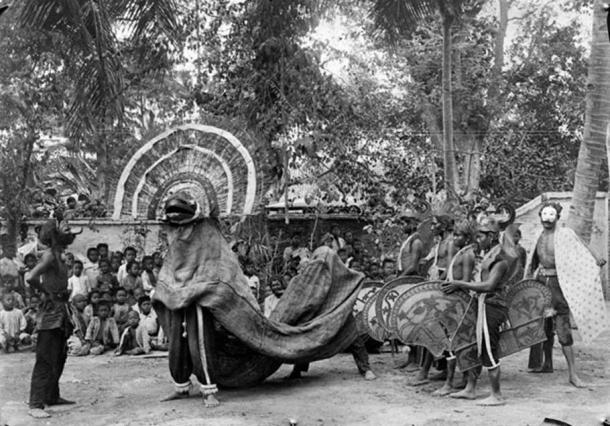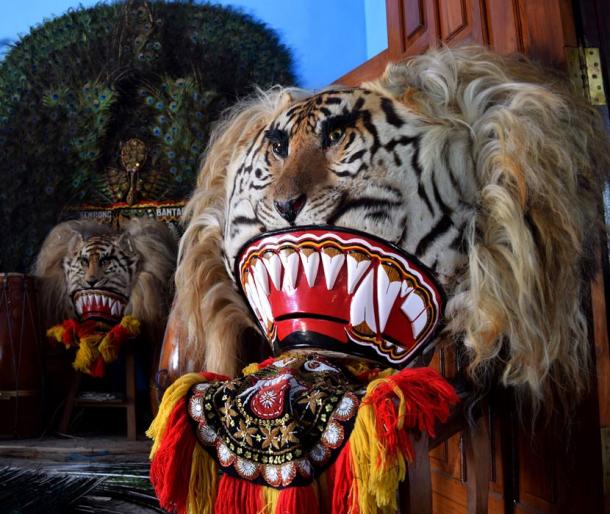A fearsome lion monster with peacock feathers on its head charged and twirled about as cavalrymen curtseyed and jumped by. The onlookers were entranced with the story playing out in front of them. This is just a taste of the Reog Ponorogo, a traditional dance which is more than just a performing art. It also involves displays of physical prowess as well as the supernatural. It is such an iconic aspect of their culture that the people of the Ponorogo Regency in Indonesia see the Reog Ponorogo as their very identity.

Reog Ponorogo performance. ( Indonesia Travel Guides )
The Reog Ponorogo is a traditional dance form originating in Ponorogo, a regency (administrative subdivision) in East Java, Indonesia. While there are various types of Reog in Indonesia, the Reog Ponorogo is one of the more well-known ones.

Reog Ponorogo dancers, 1920. ( Berita Apa Saja )
How the Reog Ponorogo Began
There are several stories regarding the origin of the Reog Ponorogo. The most popular one involves Ki Ageng Kutu, a Majapahit courtier who lived during the 15th century. Ki Ageng Kutu served in the court of Kertabhumi Bhre (often equated with Brawijaya V), the last king of the Majapahit Empire .
During this period, the empire was in decline, the court corrupt, and the king incompetent. Ki Ageng Kutu foresaw that the empire would come to an end and decided to leave the royal court. He arrived at Ponorogo and set up an institution to teach young people martial arts as well as mysticism. Ki Ageng Kutu’s hope was that his students would bring back the glory days of the Majapahit Empire.
Nevertheless, the number of his followers was small and would not be able to take on the might of the Majapahit army . Therefore, in order to bring his message to a wider audience, and to gain their support, Ki Ageng Kutu devised the Reog Ponorogo. This strategy worked, and the dance became very popular among the people of Ponorogo.
New Meaning to a Dance of Rebellion
The king of Majapahit was aware of the situation and an army was sent against Ki Ageng Kutu and his followers. Although the school was destroyed, the survivors continued to practice their arts in secret. Regarding the Reog Ponorogo, the king was unable to stop it from being performed in public as it had already gained much popularity.
Instead, new plots were added, along with new characters from the folklore of Ponorogo. The Reog Ponorogo eventually became the traditional dance of the inhabitants of Ponorogo. Today it’s performed at such special events as weddings, Islamic celebrations, and the anniversary of the Ponorogo Regency.

Reog Ponorogo performer and spectators. (Adam Cohn/ CC BY NC ND 2.0 )
Each Reog Ponorogo troupe consists of between 25 and 35 members and each performance is normally composed of 3 dance sequences. In addition, there are a number of set characters in this traditional dance form. One of these is the Jathil, who represent cavalrymen.
Traditionally, it was male dancers with feminine looks who played this role. Today, however, it is women who play this part. According to one source, the Jathil symbolize the effeminate Majapahit cavalry who served Kertabhumi Bhre.
The rich symbolism of the Reog Ponorogo can also be seen in the character of the Singa Barong, a fearsome lion monster with peacock feathers on its head. The lion is supposed to represent the Majapahit king, while the feathers his queen. This was meant as a critique of the king, who, in spite of his ferocious looks, was controlled by the queen. The mask of the Singa Barong can weigh up to 50 kg (110lbs.), and the dancer playing this part uses only his teeth to support the heavy load.

Reog Ponorogo head made of wood and tiger skin, an exotic and mystical mask. ( INDONESIAPIX /Adobe Stock)
A Case of Identity
In 2007, a Malaysian tourism commercial, which was part of the Malaysia Truly Asia campaign, featured the Tari Barongan. This is a dance similar to the Reog Ponorogo, but it was probably brought to the country by migrants from Indonesia. For the people of Ponorogo, this was regarded as identity theft, as the commercial did not acknowledge the origins of the dance.
Furthermore, the words ‘Reog Ponorogo’ on the mask of the Singa Barong was replaced with that of ‘Malaysia’, making matters worse. The silver lining, however, is that there was renewed enthusiasm for the traditional dance in the following months. Nevertheless, the spreading and development of the Reog Ponorogo in other parts of the world comes into conflict with a desire to protect this traditional dance by the people of Ponorogo. This is a thorny issue that may be resolved in the future.

A Reog Ponorogo presentation. ( Fauziah /Adobe Stock)
Top Image: Reog Ponorogo performer and spectators. Source: TirtaAjie /Adobe Stock
By Wu Mingren
Updated on October 29, 2020.
Related posts:
Views: 0
 RSS Feed
RSS Feed

















 October 30th, 2020
October 30th, 2020  Awake Goy
Awake Goy  Posted in
Posted in  Tags:
Tags: 
















